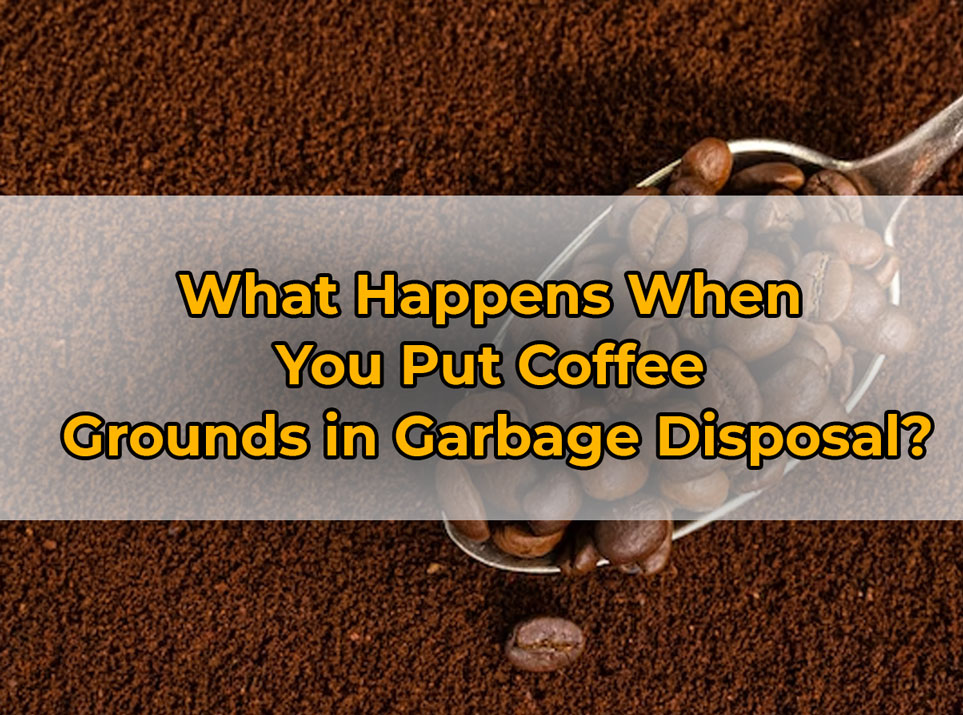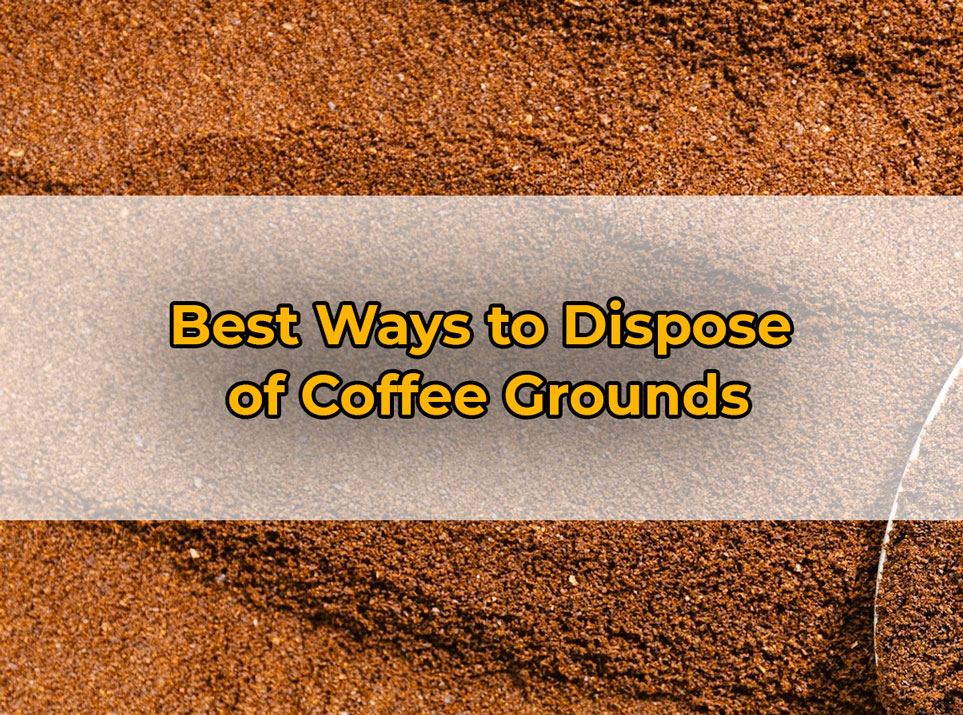Pouring coffee grounds in garbage disposal is not the best practice. It can cause blockages and dull the blades. Composting or placing them in your trash bin are better alternatives.
Coffee grounds can create a thick paste that clogs pipes and attracts pests. Avoid pouring them down the disposal.
If you still choose to dispose of them this way, run cold water and stop periodically. This will eventually harm its mechanisms.
Pro Tip: To reduce clogs, pour boiling water with salt or use baking soda with vinegar to clean any buildups. Check also: Air Switch for Garbage Disposal.
What Happens When You Put Coffee Grounds in Garbage Disposal?

Steer clear of clogs and damage; know how to dispose of coffee grounds correctly!
Here are some buildup effect you could find of you pour the coffee ground in your garbage disposal:
1. Clogging
Coffee grounds are notorious for causing issues with garbage disposals because they are dense and do not break down easily in water. When they get stuck in your disposal, they can create a thick sludge that slows down or even completely blocks the flow of water through your pipes. Here is some tips on how to unclog a garbage disposal with standing water.
This can lead to backups and unpleasant odors coming from your sink, which no one wants to deal with.
2. Damage to the blades
Coffee grounds have a coarse texture that makes them difficult to break down, which means they tend to accumulate in the drainage pipe over time.
When coffee grounds get stuck in the garbage disposal blades, it can cause them to dull or even break over time. This is because coffee grounds are abrasive and rough on metal surfaces, making it harder for your garbage disposal to grind up other food items effectively.
The accumulation of coffee grounds can also lead to clogs and slow drainage, ultimately causing damage to your plumbing system as well.
3. Pipe blockages
When you dispose of coffee grounds down your garbage disposal, they cling to the inside walls of your pipes as well as other food particles that have been disposed. Over time, these particles accumulate and form a blockage. Solve this problems: Garbage Disposal Humming but Not Working.
The problem is not only limited to home kitchens; it also affects commercial establishments such as restaurants where large quantities of coffee are brewed daily.
Best Ways to Dispose of Coffee Grounds

When we talk about discarding coffee grounds, there are many eco-friendly ways. Here are six great tips:
1. Composting
While it provides us with a much-needed boost of energy to start our day, coffee grounds are often seen as waste and thrown away without a second thought. However, used coffee grounds can actually be recycled and turned into nutrient-rich compost that can benefit your garden.
Composting is one of the best ways to dispose of coffee grounds because it helps reduce waste while also providing you with a valuable fertilizer for your plants. Coffee grounds are high in nitrogen, which is an essential nutrient for healthy plant growth.
When mixed with other organic materials like leaves and grass trimmings, they can create a rich soil amendment that will improve soil structure and increase water retention.
2. Gardening
Gardening enthusiasts are always on the lookout for ways to improve their plants’ health and growth. One method that has been gaining popularity over the years is using coffee grounds in gardening. Not only does it help dispose of used coffee grounds, but it also improves soil quality by providing essential nutrients.
Coffee grounds are an excellent source of nitrogen, which is a vital component in plant growth. Nitrogen helps the plants develop lush foliage and promotes healthy root systems.
Additionally, coffee grounds contain other essential minerals such as phosphorus and potassium that contribute to overall plant health. The acidity level of used coffee grounds also helps balance out alkaline soils, making them suitable for acid-loving plants like blueberries and rhododendrons.
The best way to use coffee grounds in gardening is to mix them into compost piles or directly add them to soil beds around your plants.
3. Drying
One of the most popular ways to dispose of coffee grounds is through drying. Drying your used coffee grounds can be a great way to repurpose them and put them to good use. This process involves spreading out your coffee grounds on a flat surface and allowing them to dry out completely.
Once the coffee grounds are fully dried, you can then use them in a variety of different ways. You can mix them with soil and use them as compost, or you can sprinkle them around your garden as a natural fertilizer. They also make for an excellent addition to homemade soaps and scrubs, adding exfoliating properties while also providing a gentle scent.
4. DIY Body Scrub
There are many benefits to using a coffee ground body scrub. Not only does it exfoliate the skin and leave it feeling soft and smooth, but it also has anti-inflammatory properties that can help reduce redness and irritation. Plus, coffee contains caffeine which can improve circulation and tighten the skin.
Making your own coffee ground body scrub couldn’t be easier. Simply mix together equal parts coconut oil and used coffee grounds until you have a thick paste. Apply it to your skin in circular motions, focusing on any areas that need extra exfoliation like elbows or knees. Rinse off with warm water and enjoy your silky smooth skin!
5. Cleaning Solution
One effective way to get rid of coffee grounds is by using them as a cleaning solution. Coffee contains natural acids that can be used to clean a variety of surfaces around your home.
For instance, you can use coffee grounds as an abrasive cleaner for pots and pans or as a deodorizer for your fridge or pantry. Simply sprinkle the grounds on the surface you want to clean and scrub away with a damp cloth.
6. Fertilizer
Sprinkle coffee grounds directly onto soil. Plants will use their minerals during growth.
Also, mix them with veggie scraps and eggshells in a worm composter. This helps create rich compost that helps plants grow strong. Don’t put coffee grounds down your garbage disposal. They can clog drains over time.
Americans throw away 400 million cups of coffee each year. Let’s reduce this waste by properly disposing of our coffee grinds – do our part! Don’t put magical items like unicorn horns and fairy dust down the garbage disposal.
Other Items to Avoid Putting in the Garbage Disposal
When running a garbage disposal, it’s important to stay away from anything that could damage it or block pipes. Avoid putting things like bones, meat scraps and fibrous vegetables like celery and corn husks in. Grease, oils and fats that harden when cold are also no-nos.
It’s worth noting that even tiny inanimate objects like toothpicks, cigarette butts and coffee stirrers can build up and cause drainage issues.
So, be careful of what you put in your disposal to keep it in good shape and reduce the need for repairs and maintenance. Regular maintenance will help keep your disposal happy and unclogged!
Tips for Maintaining a Garbage Disposal
Keep your garbage disposal in top shape!
Here’s four tips:
- Run cold water when using it.
- Only put food items in.
- Cut large pieces into small ones.
- Clean blades with ice cubes and salt.
Do not put hard items like bones or fruit pits in. Fibrous foods like celery and onion skins can clog the pipes too. Coffee grounds are a natural way to freshen your sink, but they can cause buildup over time. So, dispose of them differently.
Conclusion
Coffee grounds can cause clogs and harm your garbage disposal. It’s best to get rid of them in different ways, like composting or throwing them away. When coffee grounds are disposed of properly, they’re great for fertilizer, helping sustainability.
Gathering in the disposal, they create a sludgy mix leading to clogs and smells from garbage disposal. That means costly repairs or replacing the unit.
To avoid harm and keep your disposal running, put coffee grounds in the trash or compost bins. In compost, they add nitrogen, attract worms, and break down quickly, making nutrient-rich soil.
Don’t put coffee grounds in the disposal. It leads to plumbing costs, blocked drains, and sewer line issues. Choose smarter alternatives for waste management.
How do I dissolve coffee grounds in my garbage disposal?
One solution is to run hot water down the disposal while it’s running to help break up any remaining coffee grounds. You can also try adding some dish soap or vinegar to further dissolve them. Another option is to freeze the grounds before disposing of them, which will make them easier to break up and prevent buildup.
It’s important to note that not all foods should be disposed of in the garbage disposal, including large amounts of grease or oil. Additionally, always make sure the water is running when using the disposal and avoid putting fibrous materials like celery or corn husks down as they can get tangled around blades.
How long does it take for coffee grounds to dissolve?
Generally speaking, coffee grounds take between 30 seconds to four minutes to dissolve in hot water.
Is coffee sediment harmful?
So, is coffee sediment harmful? The answer is no. Coffee sediment is not harmful to your health if consumed in moderation. In fact, it contains antioxidants and other beneficial compounds found in coffee beans such as chlorogenic acid which can help reduce oxidative stress and inflammation in the body.
“There is no real ending. It’s just the place where you stop the story.”






